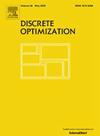Exact values of defective Ramsey numbers in graph classes
IF 0.9
4区 数学
Q3 MATHEMATICS, APPLIED
引用次数: 1
Abstract
Given a graph , a -sparse -set is a set of vertices inducing a subgraph with maximum degree at most . A -dense -set is a set of vertices that is -sparse in the complement of . As a generalization of Ramsey numbers, the -defective Ramsey number for the graph class is defined as the smallest natural number such that all graphs on vertices in the class have either a -dense -set or a -sparse -set. In this paper, we examine where represents various graph classes. For forests and cographs, we give exact formulas for all defective Ramsey numbers. For cacti, bipartite graphs and split graphs, we derive defective Ramsey numbers in most of the cases and point out open questions, formulated as conjectures if possible.
图类中有缺陷Ramsey数的精确值
给定一个图G, k-sparse j-set j是一组顶点诱导子图与最大程度最多k。k-dense我设置是一组我顶点k-sparse G·拉姆齐的泛化的补数,数量k-defective拉姆齐RkG (i, j)类图G是定义为最小的自然数n,这样所有图形顶点班上G要么k-dense我设置或k-sparse j-set。在本文中,我们研究RkG(i,j),其中G表示各种图类。对于森林和图形,我们给出了所有缺陷拉姆齐数的精确公式。对于仙人掌图、二部图和分裂图,我们在大多数情况下推导了有缺陷的Ramsey数,并指出了开放的问题,如果可能的话,将其表述为猜想。
本文章由计算机程序翻译,如有差异,请以英文原文为准。
求助全文
约1分钟内获得全文
求助全文
来源期刊

Discrete Optimization
管理科学-应用数学
CiteScore
2.10
自引率
9.10%
发文量
30
审稿时长
>12 weeks
期刊介绍:
Discrete Optimization publishes research papers on the mathematical, computational and applied aspects of all areas of integer programming and combinatorial optimization. In addition to reports on mathematical results pertinent to discrete optimization, the journal welcomes submissions on algorithmic developments, computational experiments, and novel applications (in particular, large-scale and real-time applications). The journal also publishes clearly labelled surveys, reviews, short notes, and open problems. Manuscripts submitted for possible publication to Discrete Optimization should report on original research, should not have been previously published, and should not be under consideration for publication by any other journal.
 求助内容:
求助内容: 应助结果提醒方式:
应助结果提醒方式:


